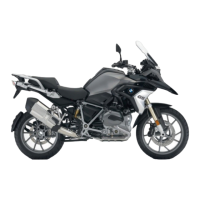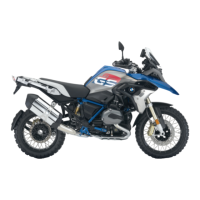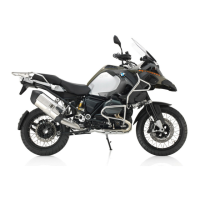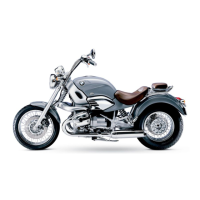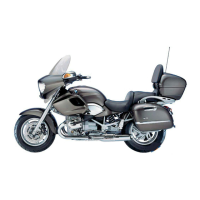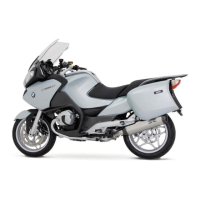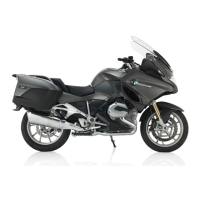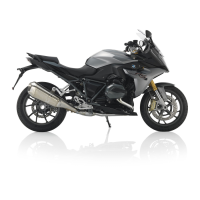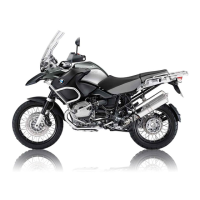Do you have a question about the BMW R 1200GS and is the answer not in the manual?
Provides a general overview of the Rider's Manual and its purpose.
Explains common abbreviations and symbols used throughout the manual.
Details the individual equipment and optional extras available for the motorcycle.
Lists dimensions, weights, and power ratings according to standards.
Explains that continuous development may lead to differences from the manual.
Illustrates and labels key components on the left side of the motorcycle.
Illustrates and labels key components on the right side of the motorcycle.
Shows and labels items located underneath the motorcycle seat.
Details the controls and functions on the left handlebar multifunction switch.
Details the controls and functions on the right handlebar multifunction switch.
Identifies and describes the various displays and indicators on the instrument panel.
Explains the meaning of various indicator and warning lights on the motorcycle.
Describes the functions and information displayed on the multifunction display.
Lists and explains warning symbols that appear in the display.
Provides an overview of how warnings are presented and their general meaning.
Explains how to operate the ignition switch and lock the handlebars.
Details the operation of the motorcycle's ignition system using Keyless Ride.
Explains the function and operation of the emergency off switch.
Covers the operation of the low-beam headlight and sidelights.
Details the functionality and operation of the daytime riding light.
Explains how to operate the hazard warning lights system.
Covers the operation of the turn indicators.
Explains how to select and view information on the multifunction display.
Details the operation and functions of the Anti-lock Brake System.
Explains the operation and functions of the Automatic Stability Control system.
Details the operation and functions of the Dynamic Traction Control system.
Explains the possible settings and operation of the Dynamic ESA system.
Describes how to select and use different riding modes for various conditions.
Details the specific features and operation of PRO riding modes.
Explains how to operate and use the cruise control system.
Details the operation and functionality of the Hill Start Control system.
Explains the activation, operation, and signals of the anti-theft alarm.
Covers the operation of the heated handlebar grips.
Details the removal and installation of the front and rear seats.
Explains how to adjust the motorcycle mirrors for optimal viewing.
Covers adjusting the headlight beam throw and spring preload.
Details how to adjust the height of the motorcycle windscreen.
Explains how to adjust the clutch lever for rider comfort.
Details how to adjust the front brake lever for rider comfort.
Describes how to adjust the angle of the handlebars.
Explains how to adjust the spring preload for the rear suspension.
Details how to adjust the damping characteristic for the rear wheel.
Provides crucial safety advice for riders, including equipment and riding practices.
Lists essential checks to be performed regularly on the motorcycle.
Outlines critical pre-ride checks to ensure safe operation.
Specifies maintenance tasks to be performed every third refueling stop.
Details the procedure for starting the motorcycle engine.
Explains the engine running-in procedure for new motorcycles.
Provides guidance and considerations for riding the motorcycle off-road.
Explains the process of shifting gears and using the shift assistant.
Covers brake system operation, including minimizing stopping distance and hazard braking.
Details procedures for parking the motorcycle safely using side and centre stands.
Provides instructions on refuelling, including fuel grade and capacity.
Explains how to properly secure the motorcycle for transport.
Offers general information and resources for engineering details.
Explains the principles, function, and effects of the ABS system.
Explains the operation and functions of the ASC system.
Explains how the DTC system works and its special situations.
Describes the Dynamic ESA system and its possible settings.
Explains the selection and characteristics of different riding modes.
Details the function, ranges, and temperature compensation of the RDC system.
Explains the operation and advantages of the Pro shift assistant.
Details the functionality and influence of the Hill Start Control system on driving behavior.
Provides general guidance on maintenance procedures and tools.
Lists and illustrates the standard toolkit provided with the motorcycle.
Describes the optional service toolkit and its uses.
Explains the procedure for installing and using the front-wheel stand.
Details how to check and top up the engine oil level.
Covers checking the brake system's function and pad thickness.
Explains how to check the clutch function.
Details how to check the coolant level and top it up.
Covers checking tyre pressure, tread depth, and rims.
Provides information on checking wheel rims and spokes.
Discusses the effect of wheel size on chassis and suspension systems.
Details how to replace the air filter element.
Explains how to replace bulbs for headlights and parking lights.
Provides instructions and precautions for jump-starting the motorcycle.
Covers battery maintenance, charging, and removal/installation.
Explains how to replace fuses and their assignments.
Details how to disengage and secure the diagnostic connector.
Provides general advice on using parts and accessories.
Explains the connection and use of electrical power sockets.
Details how to open, adjust volume, close, and remove cases.
Covers opening, adjusting volume, closing, and removing the topcase.
Explains how to secure and operate the navigation system.
Recommends specific cleaning and care products for the vehicle.
Provides instructions and precautions for washing the motorcycle.
Details how to clean plastic parts and other easily damaged components.
Offers advice on paint care, including removing stains and using polish.
Explains when and how to apply a protective wax coating to the paint.
Provides instructions for preparing the motorcycle for storage.
Details the steps required to return the motorcycle to use after storage.
Lists common problems and their solutions, particularly for engine starting issues.
Provides torque specifications for various threaded fasteners.
Details recommended and alternative fuel grades, capacity, and emissions standards.
Covers engine oil capacity, specification, topping up, and checking the level.
Provides technical specifications for the engine, including displacement and design.
Lists the clutch type and specifications.
Details the gearbox type and transmission ratios.
Provides information on the final drive type and gear ratio.
Details frame type and identification locations.
Covers front and rear suspension types, design, and spring travel.
Details front and rear brake types, pad material, and clearances.
Provides specifications for recommended tyre sets, sizes, load indices, and imbalances.
Lists electrical system ratings, fuse assignments, battery specifications, and spark plugs.
Covers activation time, alarm duration, and battery type for the anti-theft alarm.
Lists the overall dimensions of the motorcycle.
Provides vehicle kerb weight, permissible gross weight, and maximum payload.
Lists the top speed of the motorcycle.
Information on BMW Motorrad's dealership network and service capabilities.
Details available mobility services like breakdown assistance.
Outlines the BMW Pre-delivery Check and general maintenance work.
Explains the BMW Service schedule and how it is confirmed.
Provides a detailed schedule of maintenance tasks based on mileage and time.
Explains the purpose of the maintenance confirmation records.
A table for recording details of performed service work.
Information regarding the certificate for the electronic immobiliser system.
Details about the certificate for the Keyless Ride system.
Information pertaining to the certificate for the Tyre Pressure Control system.
Provides a general overview of the Rider's Manual and its purpose.
Explains common abbreviations and symbols used throughout the manual.
Details the individual equipment and optional extras available for the motorcycle.
Lists dimensions, weights, and power ratings according to standards.
Explains that continuous development may lead to differences from the manual.
Illustrates and labels key components on the left side of the motorcycle.
Illustrates and labels key components on the right side of the motorcycle.
Shows and labels items located underneath the motorcycle seat.
Details the controls and functions on the left handlebar multifunction switch.
Details the controls and functions on the right handlebar multifunction switch.
Identifies and describes the various displays and indicators on the instrument panel.
Explains the meaning of various indicator and warning lights on the motorcycle.
Describes the functions and information displayed on the multifunction display.
Lists and explains warning symbols that appear in the display.
Provides an overview of how warnings are presented and their general meaning.
Explains how to operate the ignition switch and lock the handlebars.
Details the operation of the motorcycle's ignition system using Keyless Ride.
Explains the function and operation of the emergency off switch.
Covers the operation of the low-beam headlight and sidelights.
Details the functionality and operation of the daytime riding light.
Explains how to operate the hazard warning lights system.
Covers the operation of the turn indicators.
Explains how to select and view information on the multifunction display.
Details the operation and functions of the Anti-lock Brake System.
Explains the operation and functions of the Automatic Stability Control system.
Details the operation and functions of the Dynamic Traction Control system.
Explains the possible settings and operation of the Dynamic ESA system.
Describes how to select and use different riding modes for various conditions.
Details the specific features and operation of PRO riding modes.
Explains how to operate and use the cruise control system.
Details the operation and functionality of the Hill Start Control system.
Explains the activation, operation, and signals of the anti-theft alarm.
Covers the operation of the heated handlebar grips.
Details the removal and installation of the front and rear seats.
Explains how to adjust the motorcycle mirrors for optimal viewing.
Covers adjusting the headlight beam throw and spring preload.
Details how to adjust the height of the motorcycle windscreen.
Explains how to adjust the clutch lever for rider comfort.
Details how to adjust the front brake lever for rider comfort.
Describes how to adjust the angle of the handlebars.
Explains how to adjust the spring preload for the rear suspension.
Details how to adjust the damping characteristic for the rear wheel.
Provides crucial safety advice for riders, including equipment and riding practices.
Lists essential checks to be performed regularly on the motorcycle.
Outlines critical pre-ride checks to ensure safe operation.
Specifies maintenance tasks to be performed every third refueling stop.
Details the procedure for starting the motorcycle engine.
Explains the engine running-in procedure for new motorcycles.
Provides guidance and considerations for riding the motorcycle off-road.
Explains the process of shifting gears and using the shift assistant.
Covers brake system operation, including minimizing stopping distance and hazard braking.
Details procedures for parking the motorcycle safely using side and centre stands.
Provides instructions on refuelling, including fuel grade and capacity.
Explains how to properly secure the motorcycle for transport.
Offers general information and resources for engineering details.
Explains the principles, function, and effects of the ABS system.
Explains the operation and functions of the ASC system.
Explains how the DTC system works and its special situations.
Describes the Dynamic ESA system and its possible settings.
Explains the selection and characteristics of different riding modes.
Details the function, ranges, and temperature compensation of the RDC system.
Explains the operation and advantages of the Pro shift assistant.
Details the functionality and influence of the Hill Start Control system on driving behavior.
Provides general guidance on maintenance procedures and tools.
Lists and illustrates the standard toolkit provided with the motorcycle.
Describes the optional service toolkit and its uses.
Explains the procedure for installing and using the front-wheel stand.
Details how to check and top up the engine oil level.
Covers checking the brake system's function and pad thickness.
Explains how to check the clutch function.
Details how to check the coolant level and top it up.
Covers checking tyre pressure, tread depth, and rims.
Provides information on checking wheel rims and spokes.
Discusses the effect of wheel size on chassis and suspension systems.
Details how to replace the air filter element.
Explains how to replace bulbs for headlights and parking lights.
Provides instructions and precautions for jump-starting the motorcycle.
Covers battery maintenance, charging, and removal/installation.
Explains how to replace fuses and their assignments.
Details how to disengage and secure the diagnostic connector.
Provides general advice on using parts and accessories.
Explains the connection and use of electrical power sockets.
Details how to open, adjust volume, close, and remove cases.
Covers opening, adjusting volume, closing, and removing the topcase.
Explains how to secure and operate the navigation system.
Recommends specific cleaning and care products for the vehicle.
Provides instructions and precautions for washing the motorcycle.
Details how to clean plastic parts and other easily damaged components.
Offers advice on paint care, including removing stains and using polish.
Explains when and how to apply a protective wax coating to the paint.
Provides instructions for preparing the motorcycle for storage.
Details the steps required to return the motorcycle to use after storage.
Lists common problems and their solutions, particularly for engine starting issues.
Provides torque specifications for various threaded fasteners.
Details recommended and alternative fuel grades, capacity, and emissions standards.
Covers engine oil capacity, specification, topping up, and checking the level.
Provides technical specifications for the engine, including displacement and design.
Lists the clutch type and specifications.
Details the gearbox type and transmission ratios.
Provides information on the final drive type and gear ratio.
Details frame type and identification locations.
Covers front and rear suspension types, design, and spring travel.
Details front and rear brake types, pad material, and clearances.
Provides specifications for recommended tyre sets, sizes, load indices, and imbalances.
Lists electrical system ratings, fuse assignments, battery specifications, and spark plugs.
Covers activation time, alarm duration, and battery type for the anti-theft alarm.
Lists the overall dimensions of the motorcycle.
Provides vehicle kerb weight, permissible gross weight, and maximum payload.
Lists the top speed of the motorcycle.
Information on BMW Motorrad's dealership network and service capabilities.
Details available mobility services like breakdown assistance.
Outlines the BMW Pre-delivery Check and general maintenance work.
Explains the BMW Service schedule and how it is confirmed.
Provides a detailed schedule of maintenance tasks based on mileage and time.
Explains the purpose of the maintenance confirmation records.
A table for recording details of performed service work.
Information regarding the certificate for the electronic immobiliser system.
Details about the certificate for the Keyless Ride system.
Information pertaining to the certificate for the Tyre Pressure Control system.
| Final Drive | Shaft drive |
|---|---|
| Displacement | 1170 cc |
| Power | 92 kW (125 hp) at 7, 750 rpm |
| Torque | 125 Nm at 6, 500 rpm |
| Fuel Capacity | Approx. 20 l |
| Seat Height | 850 / 870 mm |
| Front Brake | Dual 305 mm discs, 4-piston calipers |
| ABS | Standard |
| Wheelbase | 1, 507 mm |
| Transmission | Constant mesh 6-speed gearbox with helical gear teeth |
| Rear Suspension | Paralever, WAD strut (travel-related damping), spring pre-load hydraulically adjustable (continuously variable) at handwheel, rebound damping adjustable |
